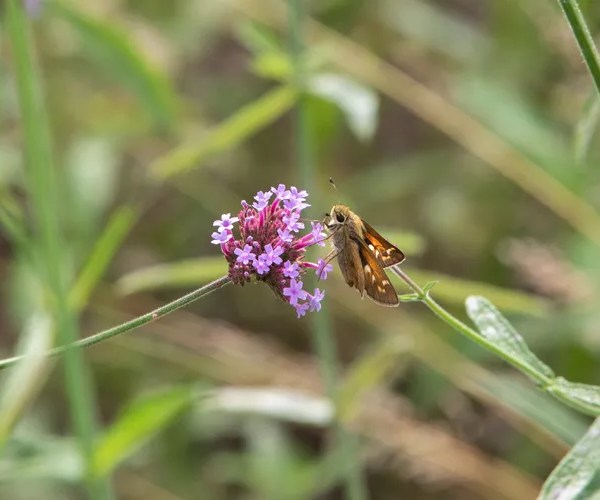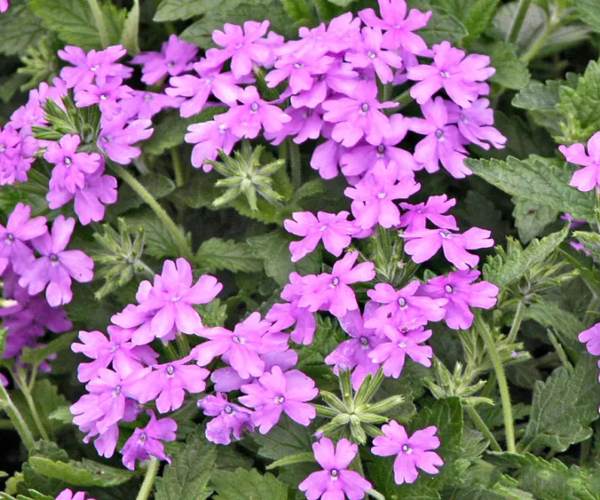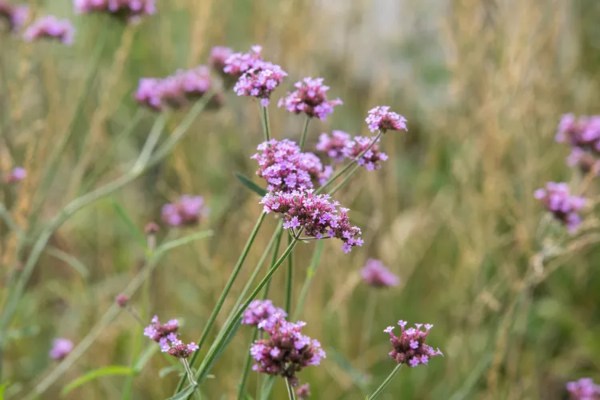Verbena plants, also commonly called vervain, are grown as annual hybrid flower bed plants and low trailers. They have dark elongated leaves with toothed edges. This plant has been historically used in making traditional medicines and essential oils because of its lemony scent and taste. While this plant is edible, its taste isn’t very good and it is used as an herb mostly.
This plant grows as hardy perennials meaning it comes year after year, in zones 8 to 11. The colorful flowers that this plant bears flowers continuously from spring to fall and grow best when eight to ten hours of full sun is given. It also prefers moderately moist, well-drained soil and good air circulation between plants.
Verbena hybrids are normally planted as potted nursery plants in the spring. You can also sow seeds indoors in plant trays in late winter. They are moderate fast-growers and will bloom by mid-summer from seeds started indoors in winter. While this is edible for humans, some varieties like lemon verbena are toxic to horses, cats, and dogs.
Plant Attribution
- Common Name: Verbena plants, annual verbena
- Botanical Name: Verbena x hybrida
- Family: Verbenaceae
- Plant Type: Annual, perennial
- Mature Size: 9–12 in. tall, 12–18 in. wide
- Sun Exposure: Full
- Soil Type: Moist, well-drained
- Soil pH: Acidic, neutral
- Bloom Time: Spring, summer, fall
- Flower Color: White, red, purple, pink, lavender, bi-colored
- Hardiness Zones: 8–11 (USDA)
- Native Area: Europe
- Toxicity: Some types are toxic to dogs, cats, horses
How to Grow Verbena
Here are the main care requirements and growth habits for a verbena plant:
- Keep the plant in a place where it gets at least six to eight hours of full sun: eight to ten is preferred.
- Water the plant regularly but avoid soggy soil conditions.
- Requires moderately moist, well-drained, and slightly acidic soil.
- Requires slow-release, balanced fertilizer once a month.
- Provide space for air circulation between plants.
Light
It is necessary to plant verbena in full sun as this plant needs six hours of sun daily. Ten hours is much better. If you plant in shady locations, flowering will be much less.
Also, Read What is Variegated Plants? Here’s What You Need to Know!
Soil
Verbena plants prefer relatively dry soil with slightly acidic to neutral pH. While this plant is not that particular about soil, the soil needs to be well-draining. Heavy clay can lead to root rot so it is better to dig in several shovelfuls of compost or leaf mold to lighten dense soils.

Water
Many parent species of these hybrids are native to Mediterranean regions or dry prairies and therefore their water requirements need to match the conditions of those regions. Once the plants become mature, just water them 1/2 to 1 inch per week. That being said, they will also tolerate short drought periods. Remember to keep the plants evenly moist until they are well-established. Soggy plants are prone to botrytus blight and drought-affected plants may suffer from spider mites.
Temperature and Humidity
As annuals, verbenas can do well in most climates except the hottest summer period. If grown as perennials, many of them are short-lived in zones 8 to 11, but some are hardy up to zone 7.
Fertilizer
Verbenas aren’t that fussy about heavy-feeding but they like a monthly feeding of balanced, slow-release flower fertilizer to help them get better blooms, which can last from spring until frost. If you’re growing one in a container, use a water-soluble fertilizer throughout the growing season. If you don’t know what amount of fertilizer to use, read the product label instructions.
Types of Verbena
It might surprise you to know that the Verbena genus has more than 250 species or lower classifications. Common verbena has been used for hundreds of years in folk medicine of different countries, including traditional Chinese medicine. Its extracts contain antioxidant, antibacterial, and anti-inflammatory properties. Verbena x” or “annual verbena” distinguishes a verbena type from the native species forms. You can identify the varieties of hybrid verbena by their unique flower colors. Here are some of its popular types:
- ‘Lanai Royal Purple with Eye‘ is a cultivar with bright purple flowers and contrasting white eyes.
- ‘Lanai Twister Pink’ has dual-tone light pink and dark pink flowers on low trailing plants.
- ‘Superbena‘ series is bred to resist powdery mildew, and it sometimes becomes a short-lived perennial as far north as Zone 7. Flowers are white or shades of lavender.
Species Types
Along with the Verbena hybrids that are known to be annual bedding and container plants, there are other pure Verbena species that you might want to try as garden perennials. These species do great in butterflies’ gardens. Taller varieties are welcome in the cottage garden, naturalized meadow, and back of the border. Many of these plants are more upright in growth habit and may look somewhat different compared to hybrid trailers.
- V. hastata (blue vervain) is a North American native that grows 6 feet tall with purplish-blue flowers. It is hardy in zones 3 to 8.
- Aloysia citrodora (lemon verbena) is a native to South America. Also known as lemon beebrush, it is grown mainly as an herb used in aromatherapy and home remedies. However, it is toxic to animals like dogs, cats, and horses.
- V. bonariensis (purple top vervain) is a native of Brazil that grows to 4 feet with lavender flowers. It is hardy in zones 7 to 11.
- Glandularia canadensis was once a member of the verbena genus but has now been recategorized. The ‘Greystone Daphne’ cultivar bears lavender-pink flowers and grows to 8 inches with a sprawling habit. It is hardy in zones 5 to 8.
- V. rigida (rigid verbena) is a spreading variety that is popular for making a good ground cover. It is hardy in zones 7 to 9. Notable cultivars include ‘Polaris’ and ‘Stantos.’
Pruning
Pruning verbena on the back several times during the growing season will help it bear better blooms and increase the longevity of the blooming season. You can shear back the plants once or twice a season to keep them looking full and tidy-looking. It is not essential to deadhead spent flowers but you can do so if you want to get more blooms.
Propagating Verbena
Stem cuttings are the best way to propagate hybrid garden verbenas. This process involves clipping stem segments and rooting them. To start, take stem cuttings to keep the plants alive through the winter and root them indoors. Then, ot them up to prepare for transplanting outdoor in the coming spring. Here is how you can do it:
- You will require sharp, sterilized pruners, rooting hormone, peat-free potting mix blended with sand or perlite, a potting container, and a clear plastic bag.
- Take 4- to 6-inch clippings from the ends of healthy stems using sterile pruners. Then, remove the leaves from the bottom one-third of the cutting and dip the cut into the rooting hormone.
- Take a small pot and fill it with a well-draining rooting medium. Plant the cutting in the potting mix and gently cover the bare part of the stem. Water the pots carefully so that the potting mix is moistened thoroughly.
- Cover the pot with a plastic cover and keep it in a spot that gets bright and indirect light. Give the cutting a timely check and moisten it with potting mix when necessary.
- Several weeks later, you can test the cutting by gently tugging on the stem. If there is resistance, you will know that the roots have developed. When new growth appears, you can transplant it into the garden or larger pots filled with commercial potting mix.
How to Grow Verbena from Seed
Most verbenas are hybrids so the new plants do not resemble their parents. If you’re thinking of propagating using seeds, get commercial seeds bred under carefully controlled greenhouse conditions.
- Start seeds indoors 12 to 14 weeks before your average last frost date to ensure flowers bloom by early summer.
- Next, wrap the seeds carefully in a moist paper towel and keep them in a plastic bag. Keep them in the refrigerator for a week.
- Plant the refrigerated seeds in cell trays with a commercial seed-starter mix.
- Gently press the seed into the soil and cover it with some extra seed-starter mix.
- Moisten the mix with a mist and then cover it with a tray. Keep it in a dark location out of direct sunlight at about 75 degrees Fahrenheit.
- In about 21 to 30 days, the seeds will start to sprout; remove the cover and keep the tray in direct sunlight.
- When the plant gets a few sets of true leaves, you can transplant the seedlings into pots that are filled with commercial potting mix or directly into the garden.
- Remember to harden off seedlings before planting them in the garden.
Potting and Repotting Verbena
You can mostly find verbena in hanging baskets with a mix of flowers where they make great “spillers” trailing over the sides of the container. You can use any normal potting mix for planting in a well-draining pot. These plants can be potted in the ground for overwintering indoors.
Also popular as annuals, these plants do not require repotting. Just discard them at the end of the growing season.

Since perennial verbenas have a short lifespan, they are not good to be permanent houseplants. But, potted verbenas are technically warm-climate perennials, so you can bring them indoors and keep them growing through the winter. If you’re bringing them inside, cut them back by a third before welcoming them in. Also, keep them in a spot where they get as much sunlight as possible.
Common Pests and Diseases
Verbenas are susceptible to powdery mildew but you can treat them with insecticidal soaps. Some main insect pests are aphids, mites, leafminers, thrips, and scales. Powdery mildew and these insects are not that fatal to the plants.
You can control powdery mildew if you water at ground level rather than through overhead spraying. Giving the plants enough space to have proper air circulation will also help reduce fungal infections.
Common Problems with Verbena Plants
Verbera plants are normally easy to grow and take care of. One common problem with hybrid verbenas is not knowing the amount of water it needs, which can ultimately cause common problems if not done right.
Plants Dry Up or Die Back
If you water verbenas too little, they dry up and ultimately die back. While they can tolerate short droughts and drier soil, longer than a few weeks in hot weather will kill them. Usually, an inch of water applied weekly is enough, but this can be too much for plants planted in poorly draining dense soils. One trick is to watch the plant and withhold water until the leaves show signs of curling, then water it thoroughly. This approach requires thorough observation.
Plants Become Leggy
Verbenas being leggy and sparse could mean that the plant is growing outward and needs more light. Make sure the plant receives at least six hours of sunlight. If the plant is getting enough sun and still gets this problem, severely prune back and feed the plant. Pruning and feeding will help stimulate thick new growth and a flush of flowering.
Plants Wilt and Turn Brown
If you are giving your plant too much water or the soil is compact, root rot is evident. Check the roots and if they appear dark brown, it’s mostly root rot. Reduce watering frequency. Apply a fungicide to curb the disease. For best results to encourage recovery, dig up the plant, cut off any black or brown root sections, apply fungicide, and replant in fresh, well-draining potting soil.
FAQs
Q: Do verbena plants spread?
A: As young verbena grow throughout the season, they spread about 12 to 18 inches wide. Plant them at least 12 inches apart. Perennial verbena will drop seeds and reseed themselves.
Q: Does verbena return year after year?
A: Verbena plants returns yearly in warm USDA zones from 8 to 11, including North Carolina, Arkansas, Texas, the Southwest U.S., and the Pacific Coast. It grows best in its preferred USDA zones and as an annual plant from spring to fall in cooler zones.
Q: How long do verbena plants live?
A: When grown as perennials, verbena plants are relatively short-lived plants, rarely living beyond two or three years. If you are producing a species type rather than a hybrid, the plants freely self-seed, and you may find it colonizing in a manner that makes it everlasting.
Q: How is this plant used in landscaping?
A: Verbena plants love the sun and are great companion plants for other sun-loving plants like coneflowers, coreopsis, lamb’s ear, phlox, and petunias. Hybrid annual verbenas are consistent bloomers often potted or used as garden bedding plants, planted in masses, or as front-edging plants where the sprawling habit is put to good use. Many hybrids have a trailing habit that works well in hanging baskets, rock gardens, or cascading over short retaining walls. Some varieties are sprawling, spreading plants that can cover good ground in sunny areas.
Also, Read How to Grow and Care for Sesame Plants!
